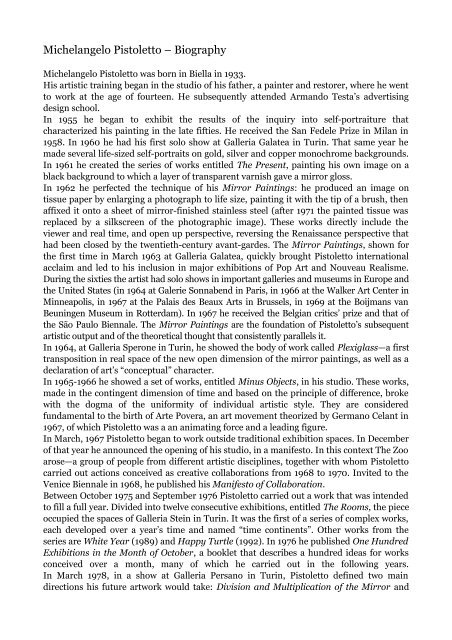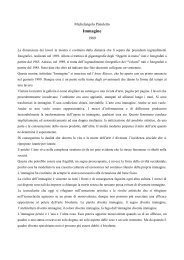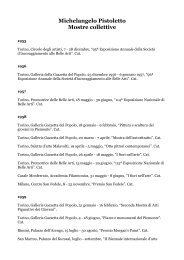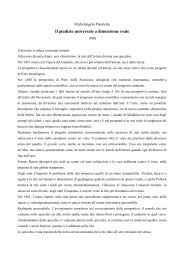Michelangelo Pistoletto – Biography
download the biography in PDF format - Pistoletto
download the biography in PDF format - Pistoletto
Create successful ePaper yourself
Turn your PDF publications into a flip-book with our unique Google optimized e-Paper software.
<strong>Michelangelo</strong> <strong>Pistoletto</strong> <strong>–</strong> <strong>Biography</strong><strong>Michelangelo</strong> <strong>Pistoletto</strong> was born in Biella in 1933.His artistic training began in the studio of his father, a painter and restorer, where he wentto work at the age of fourteen. He subsequently attended Armando Testa’s advertisingdesign school.In 1955 he began to exhibit the results of the inquiry into self-portraiture thatcharacterized his painting in the late fifties. He received the San Fedele Prize in Milan in1958. In 1960 he had his first solo show at Galleria Galatea in Turin. That same year hemade several life-sized self-portraits on gold, silver and copper monochrome backgrounds.In 1961 he created the series of works entitled The Present, painting his own image on ablack background to which a layer of transparent varnish gave a mirror gloss.In 1962 he perfected the technique of his Mirror Paintings: he produced an image ontissue paper by enlarging a photograph to life size, painting it with the tip of a brush, thenaffixed it onto a sheet of mirror-finished stainless steel (after 1971 the painted tissue wasreplaced by a silkscreen of the photographic image). These works directly include theviewer and real time, and open up perspective, reversing the Renaissance perspective thathad been closed by the twentieth-century avant-gardes. The Mirror Paintings, shown forthe first time in March 1963 at Galleria Galatea, quickly brought <strong>Pistoletto</strong> internationalacclaim and led to his inclusion in major exhibitions of Pop Art and Nouveau Realisme.During the sixties the artist had solo shows in important galleries and museums in Europe andthe United States (in 1964 at Galerie Sonnabend in Paris, in 1966 at the Walker Art Center inMinneapolis, in 1967 at the Palais des Beaux Arts in Brussels, in 1969 at the Boijmans vanBeuningen Museum in Rotterdam). In 1967 he received the Belgian critics’ prize and that ofthe São Paulo Biennale. The Mirror Paintings are the foundation of <strong>Pistoletto</strong>’s subsequentartistic output and of the theoretical thought that consistently parallels it.In 1964, at Galleria Sperone in Turin, he showed the body of work called Plexiglass—a firsttransposition in real space of the new open dimension of the mirror paintings, as well as adeclaration of art’s “conceptual” character.In 1965-1966 he showed a set of works, entitled Minus Objects, in his studio. These works,made in the contingent dimension of time and based on the principle of difference, brokewith the dogma of the uniformity of individual artistic style. They are consideredfundamental to the birth of Arte Povera, an art movement theorized by Germano Celant in1967, of which <strong>Pistoletto</strong> was a an animating force and a leading figure.In March, 1967 <strong>Pistoletto</strong> began to work outside traditional exhibition spaces. In Decemberof that year he announced the opening of his studio, in a manifesto. In this context The Zooarose—a group of people from different artistic disciplines, together with whom <strong>Pistoletto</strong>carried out actions conceived as creative collaborations from 1968 to 1970. Invited to theVenice Biennale in 1968, he published his Manifesto of Collaboration.Between October 1975 and September 1976 <strong>Pistoletto</strong> carried out a work that was intendedto fill a full year. Divided into twelve consecutive exhibitions, entitled The Rooms, the pieceoccupied the spaces of Galleria Stein in Turin. It was the first of a series of complex works,each developed over a year’s time and named “time continents”. Other works from theseries are White Year (1989) and Happy Turtle (1992). In 1976 he published One HundredExhibitions in the Month of October, a booklet that describes a hundred ideas for worksconceived over a month, many of which he carried out in the following years.In March 1978, in a show at Galleria Persano in Turin, <strong>Pistoletto</strong> defined two maindirections his future artwork would take: Division and Multiplication of the Mirror and
Art Takes On Religion. In this same month he began a one-year residency at DAAD inBerlin, in which city he presented a retrospective exhibition at the Nationalgalerie and inthirteen public places.Over the two-year period, 1978-1979, he presented a series of one-person shows,installations and actions in cities across the United States. This included CreativeCollaboration in Atlanta, a broad creative partnership extended to the entire city, in whichhe involved local artists from different disciplines together with artists with whom he hadworked in the past (actor Lionello Gennero, musician Enrico Rava, composer MortonFeldmann) and members of his family. His artistic collaborations continued throughout1979 in different places, particularly at Corniglia (Liguria), a village with whose inhabitantshe staged the play Anno Uno at the Teatro Qurino in Rome in 1981.In 1981, at Salvatore Ala Gallery in New York, <strong>Pistoletto</strong> showed The Nativity, a firstexample of the rigid polyurethane sculptures he created in the early eighties. In 1984 heremade some of these works in marble and on a large scale in his one-person show at Fortedi Belvedere in Florence.From 1985 to 1989 he created a new cycle of works, made up of surfaces and volumes inanonymous materials and dark, gloomy colors, called Art of Squalor, exhibited at GalleriaPersano in Turin and at Galleria Pieroni in Rome.In 1991 he was appointed Professor of Sculpture at the Vienna Fine Arts Academy, aposition he kept until 2000. With his students, he developed an innovative program intenton breaking down the traditional barriers between artistic disciplines.In 1993 he began the phase called Art Sign, based on an idea conceived in One HundredExhibitions in the Month of October (1976). In addition to producing a series of workssharing a form that constituted his personal Art Sign, the artist invited other people, ondiverse occasions, to create and present an Art Sign of their own.In 1994 began Project Art with which <strong>Pistoletto</strong> — by means of a program manifesto, publicmeetings, displays and exhibitions that involved artists of different disciplines and representativesof broad sectors of society — placed art at the center of socially responsible change.1998 witnessed the establishment of Cittadellarte-Fondazione <strong>Pistoletto</strong> in a former millin Biella, Italy, acquired by the artist in 1991. Here the goals expressed in Project Art arestill being developed and accomplished.2000 saw the inauguration, at the Paoli-Calmettes Cancer Institute in Marseille, of thePlace of Meditation and Prayer, a multiconfessional, secular space conceived andexecuted by the artist.In 2002 <strong>Pistoletto</strong> was Artistic Director of the Turin International Biennial of Young Artentitled Big Social Game. That same year he received the Diploma di Benemerito dellaCultura e dell’Arte from the President of the Italian Republic.In 2003 he was awarded the Golden Lion for Lifetime Achievement at the Venice Biennale.At the same Biennale he presented Love Difference - Artistic Movement for anInterMediterranean Politic, a project born in April 2002 at Cittadellarte, for which<strong>Pistoletto</strong> made a large reflecting table in the shape of the Mediterranean basin, aroundwhich many of the subsequent activities of Love Difference took place.In 2004 Turin University graduated him with a laurea honoris causa in Political Science.On that occasion the artist publicly announced the most recent phase of his work, ThirdParadise, the symbol of which is the New Infinity Sign he created in 2003. From 2007, withthe collaboration between <strong>Pistoletto</strong> and the musician Gianna Nannini, curated by Zerynthia- RAM Radioartemobile, the Third Paradise evolved into a multimedia work in progress.In 2007, in Jerusalem, <strong>Pistoletto</strong> was awarded the Wolf Foundation Prize in the Arts, “for
his constantly inventive career as an artist, educator and activist whose restless intelligencehas created prescient forms of art that contribute to fresh understanding of the world.”In 2010 he wrote the essay The Third Paradise, published in Italian, English, French andGerman. In 2011 he was the artistic director of Evento 2011 <strong>–</strong> L'art pour une ré-évolutionurbaine in Bordeaux.In 2012 he started promoting the Rebirth-day, first worldwide day of rebirth, celebratedevery year on 21st December with initiatives taking place all around the world.In 2013 the Louvre in Paris hosted his personal exhibition <strong>Michelangelo</strong> <strong>Pistoletto</strong>, annéeun <strong>–</strong> le paradis sur terre. In this same year he received the Praemium Imperiale forpainting, in Tokyo.Main solo exhibitions in museums:1966, Walker Art Center, Minneapolis; 1967, Palais des Beaux Arts, Brussels; 1969,Boymans van Beuningen Museum, Rotterdam; 1973, Kestner Gesellschaft, Hannover;1974, Matildenhohe, Darmstadt; 1976, Palazzo Grassi, Venezia; 1978, Nationalgalerie,Berlin; 1979, Rice Demenil Museum, Houston; 1983, Palacio de Cristal, Madrid; 1984,Forte di Belvedere, Firenze; 1988, P.S.1, New York; Staatliche Kunsthalle, Baden Baden;1989, Kunsthalle, Bern; Secession, Vienna; 1990, Galleria Nazionale d’Arte Moderna,Rome; 1991, Museet for Samditkunst, Oslo; 1993, Deichtorhallen, Hamburg; 1994,National Museum of Contemporary Art, Seoul; 1995, Museum des 20. Jahrhunderts,Wien; 1996, Lenbachhaus, Munich; 1997, Centro per l’Arte Contemporanea Luigi Pecci,Prato; 1999, MMAO, Oxford; Henry Moore Foundation, Halifax; Galerie Taxispalais,Innsbruck; 2000: GAM, Turin; MACBA, Barcelona; 2001: Musée d'Art Contemporain,Lyon; Contemporary Museum of Bosnia, Sarajevo; Ludwig Museum, Budapest; 2003,MuHKA, Antwerp; 2005, Galleria Civica, Modena; 2007, MAMAC, Nice; NCCA, Mosca;2010: MARCA, Catanzaro; Philadelphia Museum of Art, Philadelphia; 2011: MAXXI,Roma; 2012: Universalmuseum Joanneum, Graz; 2013: Musée du Louvre, Paris.He has participated twelve times in the Venice Biennale (1966, 1968, 1976, 1978, 1984,1986, 1993, 1995, 2003, 2005, 2009, 2011) and four times in Documenta, Kassel (1968,1982, 1992 and 1997).His works are present in the collections of leading museums of modern and contemporaryart, including:Antwerpen, MuHKA - Museum van Hedendaagse KunstBarcellona, Macba - Museu d’art contemporani de BarcelonaBerlin, Neue NationalgalerieBruxelles, Musées Royaux des Beaux-Arts de BelgiqueDallas, Dallas Museum of ArtDes Moines, Des Moines Art CenterDetroit, Detroit Institut of ArtEindhoven, Stedelijk van AbbemuseumFirenze, Galleria degli UffiziFort Worth, Modern Art Museum of Fort WorthFrankfurt am Main, MMK <strong>–</strong> Museum für Moderne KunstGent, S.M.A.K. <strong>–</strong> Stedelijk Museum voor Actuele KunstGraz, Neue Galerie am Landesmuseum Joanneum
Houston, The Menil CollectionIthaca, Herbert F. Johnson MuseumLondon, Tate ModernLos Angeles, LACMA - Los Angeles County Museum of ArtMadrid, Museo Nacional Centro de Arte Reina SofíaMarseille, MAC - Musées d´Art ContemporainMarseille, MuCEM - Museée des civilisations de l'Europe et de la MéditerraneéeMilano, Museo del NovecentoMinneapolis, Walker Art CenterMönchengladbach, Städtisches Museum AbteibergMünchen, Städtische Galerie im LenbachhausNapoli, Museo d’Arte Contemporanea Donna Regina MadreNapoli, Museo di CapodimonteNew Orleans, New Orleans Museum of ArtNew York, Brooklyn MuseumNew York, The Metropolitan Museum of ArtNew York, MoMA - The Museum of Modern ArtNew York, Solomon R. Guggenheim MuseumNice, MAMAC - Musée d'Art Moderne et d'Art ContemporainNorthampton, Smith College Museum of ArtOslo, The National Museum of Art, Architecture and DesignOtterlo, Kröller-Müller MuseumParis, Centre Georges Pompidou-Musee National d'Art ModernPorto, Fundação de Serralves - Museu de Arte ContemporâneaPrag, National Gallery - Veletrní PalacePrato, Centro per l'Arte Contemporanea Luigi PecciRivoli, Museo d'Arte Contemporanea Castello di RivoliRochechouart, Musée déepartemental d’art contemporainRoma, GNAM - Galleria Nazionale d'arte modernaRoma, MAXXI - Museo Nazionale delle Arti del XXI SecoloRotterdam, Museum Boijmans van BeuningenRovereto, Museo per l’Arte Contemporanea di Trento e Rovereto (MART)Saint-Étienne, Musee d'art modene de Saint-Étienne MetropoleSan Francisco, MOMASF-Museum of Modern ArtSeul, National Museum of Contemporary ArtTorino, GAM - Galleria Civica d’Arte Moderna e ContemporaneaToyama, The Museum of Modern Art
Toyota, Toyota Municipal Museum of ArtVaduz, Kunstmuseum LiechtensteinWashington, Hirshhorn Museum and Sculpture Garden, Smithsonian InstitutionWashington, National Gallery of ArtWien, MUMOK - Museum Moderner Kunst Stiftung Ludwigg







